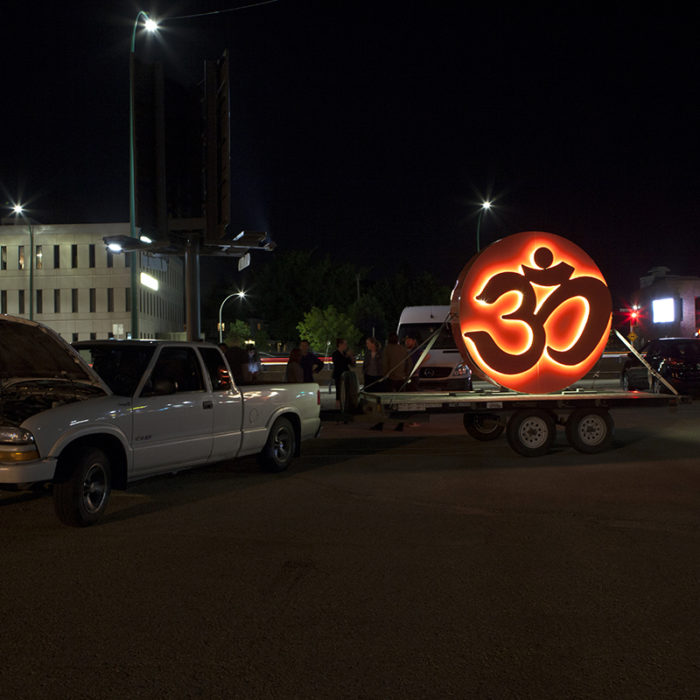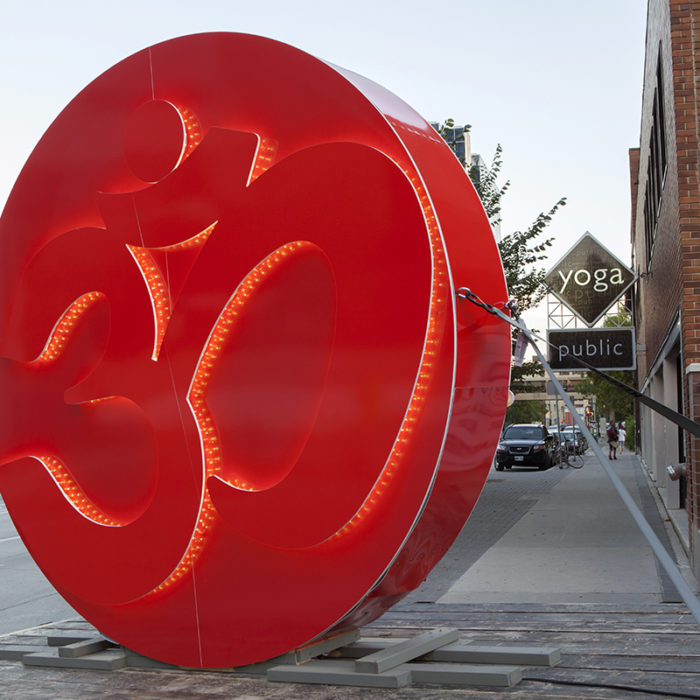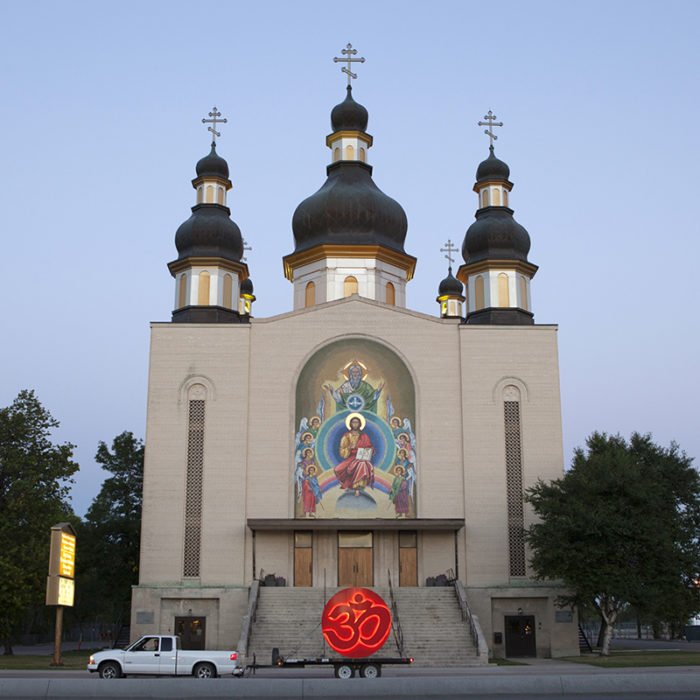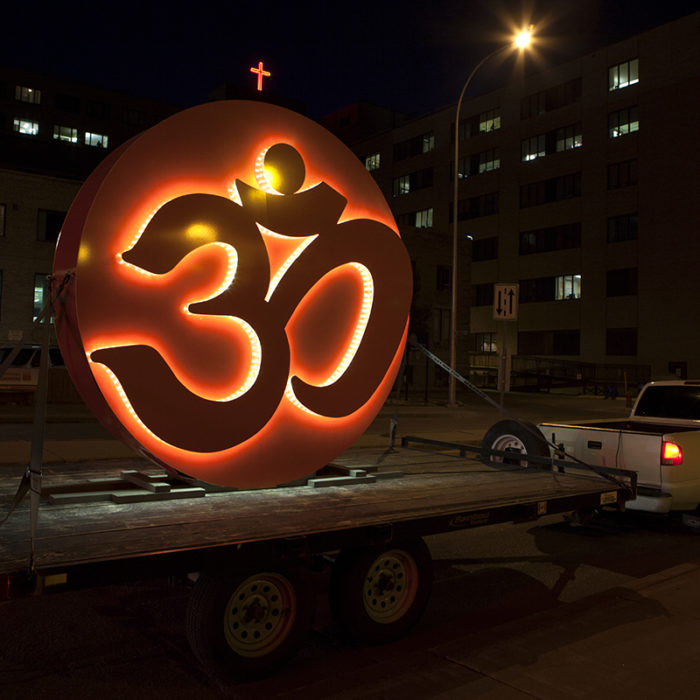Divya Mehra
WINNIPEG
Nobody pray for me, the road to hell is paved with good intentions (Mapping Identity: The Challenges of Immigrant Culture)
Sculpture; Intacel, led lighting and flatbed trailer
*This project took place as part of STAGES 2017 and is no longer on display
Location: various locations; the artwork will be transported around the city for the duration of the exhibition
Hours: Monday, Wednesday, Friday and Sunday 6pm-11pm. Tuesday, Thursday and Sunday 11am-4pm
STAGES: Drawing the Curtain • Cruise Night •
Join us on Sunday, September 3, 2017 from 9-10pm in the parking lot of Flea Whiskey pool hall (corner of Erin & Portage St.) to watch Divya Mehra’s work for STAGES: Drawing the Curtain – Nobody pray for me, the road to hell is paved with good intentions (Mapping Identity: The Challenges of Immigrant Culture) as it drives by on cruise night.
Bring a lawn chair, and a big gulp! Look for the Plug In van!
Divya Mehra often uses the aesthetic of common consumer and business signage in her artwork through which she deliver’s pointed and at times barbed commentary that references the caution and insincerity of a forced political correctness. Mehra’s work carries a relevance that aims to be transformative, advancing a conversation surrounding cultural and spiritual identity and appropriation. For STAGES, Mehra has created an 8-foot illuminated sign of the symbol Om that is being driven around the city on a flatbed trailer daily for the duration of the exhibition. The artist makes the Om symbol grand in its scale and brightness, yet keeps it unfastened. This constant displacement relates to the icon and sound’s cultural appropriation into a North American lifestyle fad, dislocating it from its traditional Hindu function as a spiritual mantra.
Divya Mehra’s work is an astute example of how art can destabilize our collective and individual perceptions about race and gender. She does this through pop cultural lines, manipulating common signs into pointed and at times barbed commentary that references the caution and insincerity of a forced political correctness. Mehra’s work carries a relevance that aims to be transformative, advancing a conversation surrounding identity. How our behaviors and responses contribute to a status quo that gives voice to diversity but remains steadfast in old hierarchies.
Working in sculpture, print, drawing, artist books, installation, advertising, video, and most recently film, Mehra is known for her meticulous attention to the interaction of form, medium, and site. Through an acerbic tone, she addresses the long-term effects of colonization and institutional racism. Re-contextualizing references found in hip hop, literature, and current affairs, she contends with contemporary expressions of societies (India, America, Canada) continuously formed by their colonial roots. Mehra’s practice explores diasporic identities, racialization, otherness, and the construct of “diversity.” Mehra’s work has been presented as part of exhibitions and commissions with, Creative Time, MoMA PS1, MTV, and The Queens Museum of Art (New York), MASS MoCA (North Adams), Artspeak (Vancouver), The Images Festival (Toronto), The Beijing 798 Biennale (Beijing), Bielefelder Kunstverein (Bielefeld), and Latitude 28 (Delhi). Mehra holds an MFA from Columbia University and is represented in Toronto by Georgia Scherman Projects. She currently divides her time between Winnipeg, Delhi, and New York.
L’oeuvre de Divya Mehra montre astucieusement comment l’art peut déstabiliser nos perceptions individuelles et collectives des races et des genres. Elle le fait en traçant des lignes de pop culture, manipulant les signes ordinaires en les transformant en commentaires acerbes comme du fil barbelé qui montrent la prudence et le manque de sincérité du politiquement correct forcé. Le travail de Mehra porte en lui une pertinence transformative, promouvant une conversation autour de l’identité. Comment nos comportements et nos réactions contribuent au status quo qui donne sa voix à la diversité mais reste fermement dans les hiérarchies anciennes. Travaillant la sculpture, les tirages, la peinture, les livres d’artistes, les installations, la publicité, la vidéo et plus récemment le film, Mehra est réputée pour son attention méticuleuse à l’interaction des formes, des média et du lieu. Avec un ton acerbe, elle aborde le sujet des effets à long terme de la colonisation et du racisme institutionnel. En re-contextualisant des références issues du hip hop, de la littérature et de l’actualité, elle lutte contre les expression contemporaines de sociétés (Inde, Amérique, Canada) formées de façon continue sur leur racines coloniales. La pratique de Mehra explore les identités en diaspora, la racialisation, l’altérité< et la construction de la diversité. Les oeuvre de Mehra ont été présenté dans des expositions et commandes telles que Creative Time, MoMA PS1, MTV, et le Queens Museum of Art (New York), MASS MoCA (North Adams), Artspeak (Vancouver), The Images Festival (Toronto), The Beijing 798 Biennale (Beijing), Bielefelder Kunstverein (Bielefeld), and Latitude 28 (Delhi). Mehra détient une Maîtrise ès Arts deColumbia University et est représentée à Toronto parGeorgia Scherman Projects. Elle passe aujourd’hui son temps entre Winnipeg, Delhi et New York.






